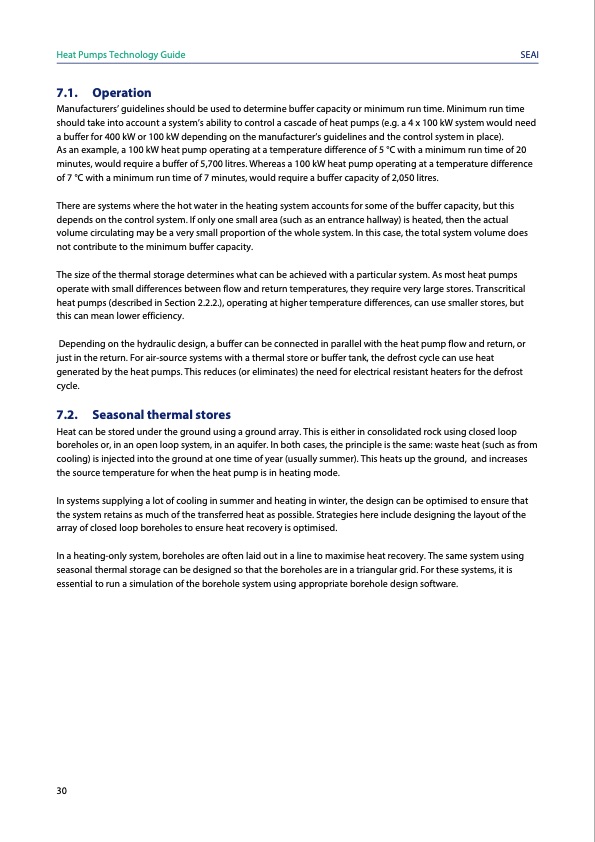
PDF Publication Title:
Text from PDF Page: 034
Heat Pumps Technology Guide SEAI 7.1. Operation Manufacturers’ guidelines should be used to determine buffer capacity or minimum run time. Minimum run time should take into account a system’s ability to control a cascade of heat pumps (e.g. a 4 x 100 kW system would need a buffer for 400 kW or 100 kW depending on the manufacturer’s guidelines and the control system in place). As an example, a 100 kW heat pump operating at a temperature difference of 5 °C with a minimum run time of 20 minutes, would require a buffer of 5,700 litres. Whereas a 100 kW heat pump operating at a temperature difference of 7 °C with a minimum run time of 7 minutes, would require a buffer capacity of 2,050 litres. There are systems where the hot water in the heating system accounts for some of the buffer capacity, but this depends on the control system. If only one small area (such as an entrance hallway) is heated, then the actual volume circulating may be a very small proportion of the whole system. In this case, the total system volume does not contribute to the minimum buffer capacity. The size of the thermal storage determines what can be achieved with a particular system. As most heat pumps operate with small differences between flow and return temperatures, they require very large stores. Transcritical heat pumps (described in Section 2.2.2.), operating at higher temperature differences, can use smaller stores, but this can mean lower efficiency. Depending on the hydraulic design, a buffer can be connected in parallel with the heat pump flow and return, or just in the return. For air-source systems with a thermal store or buffer tank, the defrost cycle can use heat generated by the heat pumps. This reduces (or eliminates) the need for electrical resistant heaters for the defrost cycle. 7.2. Seasonal thermal stores Heat can be stored under the ground using a ground array. This is either in consolidated rock using closed loop boreholes or, in an open loop system, in an aquifer. In both cases, the principle is the same: waste heat (such as from cooling) is injected into the ground at one time of year (usually summer). This heats up the ground, and increases the source temperature for when the heat pump is in heating mode. In systems supplying a lot of cooling in summer and heating in winter, the design can be optimised to ensure that the system retains as much of the transferred heat as possible. Strategies here include designing the layout of the array of closed loop boreholes to ensure heat recovery is optimised. In a heating-only system, boreholes are often laid out in a line to maximise heat recovery. The same system using seasonal thermal storage can be designed so that the boreholes are in a triangular grid. For these systems, it is essential to run a simulation of the borehole system using appropriate borehole design software. 30PDF Image | Heat Pumps Technology Guide

PDF Search Title:
Heat Pumps Technology GuideOriginal File Name Searched:
Heat-Pump-Technology-Guide.pdfDIY PDF Search: Google It | Yahoo | Bing
CO2 Organic Rankine Cycle Experimenter Platform The supercritical CO2 phase change system is both a heat pump and organic rankine cycle which can be used for those purposes and as a supercritical extractor for advanced subcritical and supercritical extraction technology. Uses include producing nanoparticles, precious metal CO2 extraction, lithium battery recycling, and other applications... More Info
Heat Pumps CO2 ORC Heat Pump System Platform More Info
| CONTACT TEL: 608-238-6001 Email: greg@infinityturbine.com | RSS | AMP |